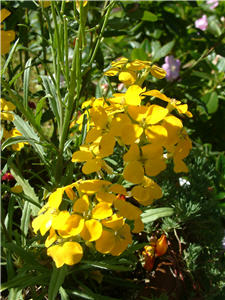Irrigation Tips
You can save literally thousands of gallons of water on your landscape, and save your plants from drowning, just by ensuring the proper settings of your irrigation controller.
- Basic Watering Information
- General Tips
- Watering Device Types
- Common Irrigation Challenges
- Watering Schedule - Coastal Areas
- Watering Schedule - Coastal Valleys
- Watering Schedule - North County
- Irrigation Tips



Programming your irrigation controller:
- Set the current time and day and replace the back-up battery that holds the program memory.
- Start with program A for your lawn areas. Group stations or valves that require the same watering frequencies together on the same program.
- Select each station and enter the minutes of watering time for each valve.
- Select the time you'd like your irrigation to start. You can have 2 or 3 different start times per day. Program start times should be one or more hours apart to allow the water to soak in and prevent run-off.
- Select the days you want your irrigation to run, making sure you don't water on the same day you mow the lawn.
- Program A is complete. Use programs B & C for other zones that require less water, such as ground covers, shrubs, low water use plantings, etc.
Definitions
SPRING - The season of growth! March, April and May are considered the months of spring in California. Typically plants start to require supplemental water from irrigation systems during these months. With no rainfall and temperatures in this range, use the spring schedule.
SUMMER - The warmest season of the year. June, July, and August are the months when plants slow their growth because the heat stresses their growing ability. July is typically the hottest month of the year requiring an average of 6.75 inches of irrigation for lawns. Re-set your controller to provide the necessary water for summer.
FALL - The season of harvest. September, October, and November are considered the months of fall. As the days get shorter and temperature drops, you don't need to water as frequently as you did in the middle of summer. The average inches of irrigation for lawns are: September – 4.5", October - 3.5" and November - 2".
WINTER - The season of short days and lowest temperatures. December, January, and February are considered the months of winter. Rainfall normally takes care of any water requirements for your landscaping during this period. Colder temperatures slow plant growth and eliminate the need for additional water from irrigation systems. It is very important to turn your controller off during these months. In dry years supplemental water might be needed as early as February.
DAYS PER WEEK: Typical irrigation controllers allow a program to be scheduled to operate any day of the week. Operation can happen on any number of selected days. Adding or subtracting days is a common way to adjust controllers for increasing or decreasing seasonal water requirements. Multiple Programs A, B, and C, allow you to run different valves on different days with different run times.
MINUTES PER STATION: Each station or valve is given a run time in minutes that is determined by the amount of time it takes for water to saturate the soil and start running off. A typical time for water to run off in clay soils with a spray system is 5 minutes. This is the maximum amount of watering time that you should apply to allow the soil to absorb the water. This is known as "Cycle and Soak". Apply water and allow time for it to soak in before applying additional required water.
START TIMES PER DAY: Each program in the controller has two to four start times depending on the model of the irrigation controller. Repeated start times allows for the "Cycle and Soak" principle by giving time for the water to be absorbed into the soil and thereby avoid run-off . If we need 10 minutes of watering, per day, then we would use two start times one hour apart with a 5 minute station run time each. Start times for different programs should not conflict with each other.
TOTAL MINUTES PER WEEK: We assume the irrigation system is well designed and maintained. Your individual irrigation system may apply water faster or slower based on the design, type and spacing of sprinkler heads. Also, significant differences in temperatures can occur throughout the year that are out of the monthly averages. For these reasons YOU MAY HAVE TO ADJUST UP OR DOWN to meet the watering needs of your lawns and landscaping.